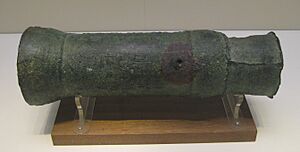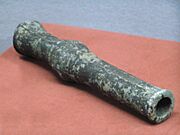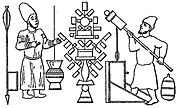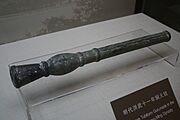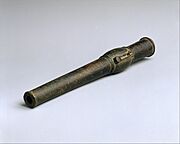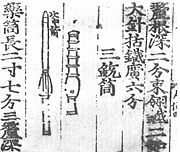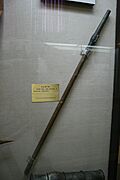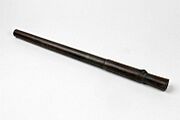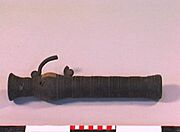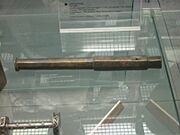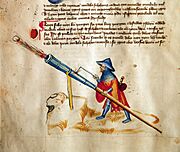Hand cannon facts for kids
The hand cannon was one of the very first true firearms ever made! It was a simple type of gun that people could hold and fire. Think of it as an early version of a handgun.
Unlike modern guns, hand cannons didn't have a trigger. To fire them, you had to light the gunpowder directly through a small hole called a touch hole.
Hand cannons were first used a lot in China in the 1200s. From there, they spread across Eurasia in the 1300s. Later, in Europe during the 1400s, the hand cannon developed into the matchlock arquebus, which was the first gun to have a trigger.
Contents
History of Hand Cannons

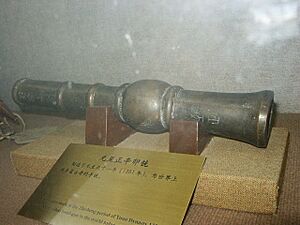
Hand Cannons in China
The very first cannons likely grew out of earlier weapons called "fire lances." These were like tubes that shot out fire and sometimes small bits of shrapnel. Over time, people started making these tubes from metal instead of bamboo or wood. This made them strong enough to handle the powerful explosion of gunpowder.
Hand cannons became widely used in China during the 1200s. For example, in 1287, soldiers from the Yuan dynasty used hand cannons to stop a rebellion. Reports from that time say the cannons "caused great damage" and made the enemy soldiers confused. These soldiers could even carry the hand cannons on their backs!
One of the oldest hand cannons we still have today is the Xanadu Gun, which is from 1298. Another one, the Heilongjiang hand cannon, might be even older, from 1288.
Li Ting chose gun-soldiers, hiding those who carried the cannons on their backs. Then, at night, he crossed the river, moved upstream, and fired the weapons. This made all the enemy's horses and men very confused... and he won a great victory.
How Hand Cannons Spread
Cannons started appearing in Europe around 1326. The first time gunpowder weapons were used in Europe was in 1331. By 1338, hand cannons were common in France.
One of the oldest surviving hand cannons from Europe is the "Loshult gun" from Sweden, made in the mid-1300s. Researchers made a copy of it and tested it. They found it could shoot arrows up to 360 meters and lead balls up to 630 meters!
In the Middle East, fire lances were known earlier, but hand cannons likely appeared in the early 1300s. An Arabic text from 1320–1350 describes a gunpowder weapon called a midfa. Some experts believe this was a hand cannon. Cannons were definitely used by the Mamluks by 1342.
Description of the mixture to be put in the cannon: gunpowder, ten parts; charcoal, two parts; sulfur, one and a half parts. Grind it all into a fine powder and fill one-third of the cannon. Do not put more, or it might explode. This is why you should ask a craftsman to make a wooden cannon that fits its opening. Put the mixture in firmly; add the balls or the arrow and light the fuse. The cannon's length must fit the hole. If the cannon was deeper than the opening's width, this would be a problem. Take care of the gunners. Be careful.
– Rzevuski MS, c. 1320–1350
Cannons were used in India starting in 1366. The Joseon kingdom in Korea learned about gunpowder from China by 1372 and began making cannons by 1377. In Southeast Asia, soldiers in Đại Việt (modern-day Vietnam) used hand cannons by 1390. Chinese travelers even saw Javanese people using hand cannons for a wedding ceremony in 1413.
Japan knew about gunpowder from the Mongol invasions in the 1200s. However, they didn't get a cannon until a monk brought one from China in 1510. Firearms weren't made in Japan until 1543, when the Portuguese introduced matchlocks.
The Arquebus
Early European hand cannons were often made from brass or bronze. Making them wasn't always perfect, which could cause problems when loading or firing.
Over time, hand cannons got better. Gunpowder was improved, and people started using round shots (bullets). A new part called a "flash pan" was added. These improvements led to the invention of the arquebus in Europe in the late 1400s. The arquebus was a big step forward because it was the first firearm to have a trigger mechanism.
Design and Features

A hand cannon usually had a metal barrel, a handle, and sometimes a place to attach a wooden stock. Some even had a metal extension that worked as a handle.
To fire a hand cannon, you could hold it with two hands. Often, another person would help by lighting the gunpowder with a burning stick, hot coal, or a slow-burning match. Sometimes, a gunner could rest the cannon on a support and light it themselves with one hand.
At first, hand cannons shot things like rocks, pebbles, or arrows. Later, people started using stone balls, and then, in the late 1300s and 1400s, they switched to iron balls.
Later hand cannons had a flash pan attached to the side of the barrel, with the touch hole drilled through the side instead of the top. The flash pan had a cover to keep the gunpowder dry and prevent it from firing too early. These important features were then used in many firearms that came after the hand cannon.
Gallery
Asia
-
Hand cannon from the Mongol Yuan dynasty (1271–1368).
-
A hand cannon from the Ming dynasty, 1377.
-
Another hand cannon from the Ming dynasty, 1379.
Europe
See also


